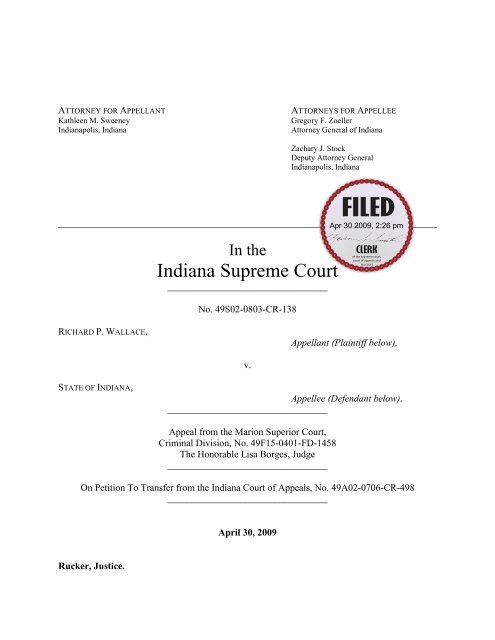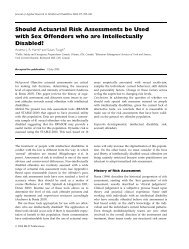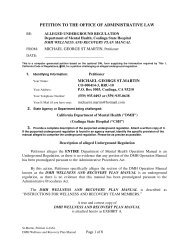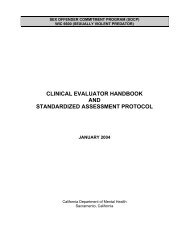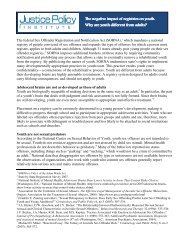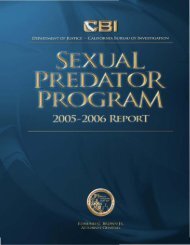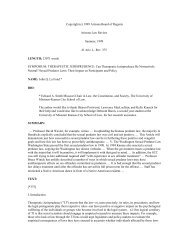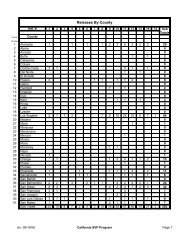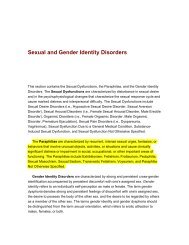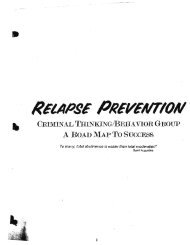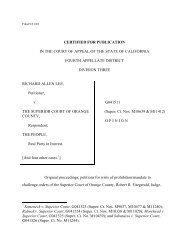Richard P. Wallace v. State of Indiana - Blog
Richard P. Wallace v. State of Indiana - Blog
Richard P. Wallace v. State of Indiana - Blog
You also want an ePaper? Increase the reach of your titles
YUMPU automatically turns print PDFs into web optimized ePapers that Google loves.
ATTORNEY FOR APPELLANTKathleen M. Sweeney<strong>Indiana</strong>polis, <strong>Indiana</strong>ATTORNEYS FOR APPELLEEGregory F. ZoellerAttorney General <strong>of</strong> <strong>Indiana</strong>Zachary J. StockDeputy Attorney General<strong>Indiana</strong>polis, <strong>Indiana</strong>______________________________________________________________________________In the<strong>Indiana</strong> Supreme Court_________________________________No. 49S02-0803-CR-138RICHARD P. WALLACE,Appellant (Plaintiff below),v.STATE OF INDIANA,Appellee (Defendant below)._________________________________Appeal from the Marion Superior Court,Criminal Division, No. 49F15-0401-FD-1458The Honorable Lisa Borges, Judge_________________________________On Petition To Transfer from the <strong>Indiana</strong> Court <strong>of</strong> Appeals, No. 49A02-0706-CR-498_________________________________April 30, 2009Rucker, Justice.
SummaryThe statutes collectively referred to as the <strong>Indiana</strong> Sex Offender Registration Act (“Act”)require defendants convicted <strong>of</strong> sex and certain other <strong>of</strong>fenses to register with local lawenforcement agencies and to disclose detailed personal information, some <strong>of</strong> which is nototherwise public. In this case we consider a claim that the Act constitutes retroactive punishmentforbidden by the Ex Post Facto Clause contained in the <strong>Indiana</strong> Constitution because it applies toa defendant who committed his <strong>of</strong>fense before the statutes were enacted. We conclude that asapplied in this case the Act violates the constitutional provision.Facts and Procedural HistoryIn 1988, <strong>Richard</strong> <strong>Wallace</strong> was charged with one count <strong>of</strong> child molesting as a Class Bfelony and one count <strong>of</strong> child molesting as a Class C felony. Under terms <strong>of</strong> a plea agreement<strong>Wallace</strong> pleaded guilty to the Class C felony count on February 15, 1989. The trial courtimposed a five-year suspended sentence with various conditions <strong>of</strong> probation. <strong>Wallace</strong>completed probation in 1992. Two years later the <strong>Indiana</strong> Legislature passed the Act that,among other things, required probationers and parolees convicted <strong>of</strong> child molesting on or afterJune 30, 1994 to register as sex <strong>of</strong>fenders. In 2001 the Act was amended to require all <strong>of</strong>fendersconvicted <strong>of</strong> certain sex <strong>of</strong>fenses to register as sex <strong>of</strong>fenders regardless <strong>of</strong> conviction date.In 2003, <strong>Wallace</strong>‟s ex-wife notified authorities that <strong>Wallace</strong> had been convicted <strong>of</strong> a sex<strong>of</strong>fense but had never registered as an <strong>of</strong>fender. The Sex Offender Registration Coordinator forthe <strong>Indiana</strong>polis Police Department investigated the matter, concluded <strong>Wallace</strong> was required toregister, and sent <strong>Wallace</strong> a letter to that effect. <strong>Wallace</strong> responded to the Coordinator onDecember 31, 2003, and insisted that he did not have to register as a sex <strong>of</strong>fender because theplea agreement executed in 1989 did not require him to do so.After <strong>Wallace</strong> did not register, he was charged with failing to register as a sex <strong>of</strong>fender asa Class D felony. <strong>Wallace</strong> subsequently filed a motion to dismiss, which the trial court denied.Following a trial by jury on January 31, 2007, he was found guilty as charged. The trial court2
sentenced <strong>Wallace</strong> to 545 days <strong>of</strong> incarceration, all suspended to probation. He appealed raisingthree claims: (1) the plea agreement foreclosed the <strong>State</strong>‟s ability to prosecute him for failing toregister as a sex <strong>of</strong>fender, (2) the evidence was insufficient to support the conviction, and (3) theAct violates the ex post facto provisions <strong>of</strong> both the <strong>Indiana</strong> and federal Constitutions. TheCourt <strong>of</strong> Appeals affirmed the judgment <strong>of</strong> the trial court. <strong>Wallace</strong> v. <strong>State</strong>, 878 N.E.2d 1269,1277 (Ind. Ct. App. 2008).Having previously granted transfer we now reverse the judgment <strong>of</strong> the trial court on<strong>Wallace</strong>‟s ex post facto claim. In all other respects we summarily affirm the opinion <strong>of</strong> the Court<strong>of</strong> Appeals.BackgroundI. Advent <strong>of</strong> Sex Offender Registry StatutesThe <strong>State</strong> <strong>of</strong> New Jersey gained national recognition after enacting a sex <strong>of</strong>fenderregistration statute that has become known as “Megan‟s Law,” named after a child abducted,sexually assaulted, and murdered by a known child molester who had moved across the streetfrom the child‟s family without their knowledge. The constitutionality <strong>of</strong> the New Jerseylegislation was upheld by the New Jersey Supreme Court in Doe v. Poritz, 662 A.2d 367 (N.J.1995).In 1994, Congress adopted the Jacob Wetterling Crimes Against Children and SexuallyViolent Offenders Registration Act to encourage individual states to adopt sex <strong>of</strong>fenderregistration statutes. Under the Wetterling Act, if a state did not adopt some version <strong>of</strong>Megan‟s Law with certain provisions, Congress could withhold ten percent <strong>of</strong> certain grants thestate would ordinarily receive for a variety <strong>of</strong> crime prevention and interdiction programs. See42 U.S.C. § 14071(f) (1995) (current version at 42 U.S.C. § 14071(g)).All fifty states and the District <strong>of</strong> Columbia responded in kind which generated anexplosion <strong>of</strong> litigation challenging the laws under various constitutional provisions including3
federal and state ex post facto clauses 1 and inspired vigorous academic debate. 2 The United<strong>State</strong>s Supreme Court has also weighed in on the subject declaring in 2003 that the registrationrequirements imposed by the Alaska Sex Offender Registration Act were non-punitive andcreated a civil regime; therefore, the registration requirement could be applied retroactivelywithout violating the Ex Post Facto Clause <strong>of</strong> the United <strong>State</strong>s Constitution. Smith v. Doe, 538U.S. 84, 105-06 (2003). 3II. The <strong>Indiana</strong> ResponseA. Initial Sex Offender Registration ActThe <strong>Indiana</strong> General Assembly adopted its first version <strong>of</strong> Megan‟s Law in July 1994.Referred to as “Zachary‟s Law,” 4 the Act required persons convicted <strong>of</strong> certain sex crimes toregister as “sex <strong>of</strong>fender[s].” Act <strong>of</strong> March 2, 1994, Pub.L. No. 11-1994, § 7 (codified as<strong>Indiana</strong> Code §§ 5-2-12-1 – 5-2-12-13) (current version at <strong>Indiana</strong> Code §§ 11-8-8-1 – 11-8-8-1 See, e.g., E.B. v. Verniero, 119 F.3d 1077 (3d Cir. 1997); Fushek v. <strong>State</strong>, 183 P.3d 536 (Ariz. 2008);Kellar v. Fayetteville Police Dep‟t, 5 S.W.3d 402 (Ark. 1999); People v. Castellanos, 982 P.2d 211, 215(Cal. 1999); <strong>State</strong> v. Seering, 701 N.W.2d 655 (Iowa 2005); <strong>State</strong> v. Myers, 923 P.2d 1024 (Kan. 1996);Doe v. District Attorney, 932 A.2d 552 (Me. 2007); Garrison v. <strong>State</strong>, 950 So.2d 990 (Miss. 2006); <strong>State</strong>v. Ferguson, 896 N.E.2d 110 (Ohio 2008); Commonwealth v. Lee, 935 A.2d 865 (Pa. 2007).2 See, e.g., Michele L. Earl-Hubbard, Comment, The Child Sex Offender Registration Laws: ThePunishment, Liberty Deprivation, and Unintended Results Associated with the Scarlet Letter Laws <strong>of</strong> the1990s, 90 Nw. U. L. Rev. 788 (1996); G. Scott Rafshoon, Comment, Community Notification <strong>of</strong> SexOffenders: Issues <strong>of</strong> Punishment, Privacy, and Due Process, 44 Emory L.J. 1633 (1995); Lori N. Sabin,Note, Doe v. Poritz: A Constitutional Yield to an Angry Society, 32 Cal. W. L. Rev. 331 (1996); SimeonSchopf, “Megan’s Law”: Community Notification and the Constitution, 29 Colum. J.L. & Soc. Probs.117 (1995).3 Doe thereafter returned to state court and challenged the Act on state law grounds. The Alaska SupremeCourt concluded the Act violated the Ex Post Facto Clause <strong>of</strong> the Alaska Constitution as applied to Doe.See Doe v. <strong>State</strong>, 189 P.3d 999, 1019 (Alaska 2008) (adopting the analytical approach used by the United<strong>State</strong>s Supreme Court to evaluate ex post facto claims, but declaring, “Our interpretation <strong>of</strong> a clause in theAlaska Constitution is not limited by the Supreme Court‟s interpretation <strong>of</strong> the corresponding federalclause,” Doe, 189 P.3d at 1006).4 Zachary‟s Law was passed in honor <strong>of</strong> Zachary Snider, a 10-year-old boy from Cloverdale, <strong>Indiana</strong> whowas molested and murdered by a previously convicted child molester. Overview <strong>of</strong> Zachary‟s Law,http://www.allencountysheriff.org/sex<strong>of</strong>fender/zachary.html (last visited April 23, 2009). See alsoStevens v. <strong>State</strong>, 691 N.E.2d 412 (Ind. 1997) (upholding Stevens‟ conviction for the murder <strong>of</strong> Zachary).4
22). The Act contained both registration and notification provisions, i.e., sex <strong>of</strong>fenders wererequired to take affirmative steps to notify law enforcement authorities <strong>of</strong> their whereabouts, andthat information was then disseminated to the public. In 1994, eight crimes triggered status as asex <strong>of</strong>fender and the statute applied only to <strong>of</strong>fenders who resided or intended to reside in<strong>Indiana</strong>. Ind. Code §§ 5-2-12-4, -5 (1994). Registration involved providing limited informationto law enforcement agencies where the <strong>of</strong>fender resided and updating that information if the<strong>of</strong>fender moved to a new municipality or county in <strong>Indiana</strong>. Id. at -8. Notification involved thedistribution <strong>of</strong> a paper registry, updated twice per year and sent automatically to a few selectagencies. Id. at -11. Other entities could receive the registry on request, but the home addresses<strong>of</strong> the registrants were withheld. Id.B. Subsequent Amendments to the ActSince its inception in 1994 the Act has been amended several times. What began as ameasure to give communities notification necessary to protect children from sex <strong>of</strong>fenders, theAct has expanded in both breadth and scope. We summarize below the amendments mostrelevant to the case before us.The number <strong>of</strong> sex <strong>of</strong>fenses that trigger the registration requirement has increased fromeight to twenty-one, and has expanded to include murder, voluntary manslaughter, and undercertain circumstances kidnapping and criminal confinement. Ind. Code §§ 11-8-8-5, -7 (Supp.2008). The length <strong>of</strong> time in which an <strong>of</strong>fender has a duty to register has also increased.Originally the duty to register was prospective only, and terminated when the <strong>of</strong>fender was nolonger on probation or discharged from parole. Ind. Code § 5-2-12-13 (1994). But in 1995 theduty to register expanded to ten years after the date the <strong>of</strong>fender was released from prison, placedon parole, or placed on probation, whichever occurred last. Ind. Code § 5-2-12-13 (1995).Aside from the registration component <strong>of</strong> the Act, over the years the notificationcomponent <strong>of</strong> the Act also expanded. Under a 1998 amendment, once an <strong>of</strong>fender is dischargedfrom a correctional facility, the facility is required to provide the local law enforcementauthorities with, among other things, the <strong>of</strong>fender‟s fingerprints, photograph, address where the5
<strong>of</strong>fender is expected to live, complete criminal history, and any information concerning the<strong>of</strong>fender‟s treatment <strong>of</strong> mental disorders. Ind. Code § 5-2-12-7 (1998). The 2001 amendmentalso requires information concerning any address at which the <strong>of</strong>fender spends more than sevendays, and the name and address <strong>of</strong> the <strong>of</strong>fender‟s employment or school attendance. Ind. Code §5-2-12-5 (2002) (amended January 1, 2003) (current version at I.C. § 11-8-8-7). A 2008amendment requires the disclosure <strong>of</strong> any electronic mail address, instant messaging username,electronic chat room username, or social networking web site username that a sex <strong>of</strong>fender usesor intends to use. Ind. Code § 11-8-8-8 (Supp. 2008).Verification <strong>of</strong> the disclosed information has also become more expansive. A 1998amendment to the Act requires local law enforcement to verify the <strong>of</strong>fender‟s current residenceby mailing a form to the <strong>of</strong>fender at least once per year, which the <strong>of</strong>fender must return either bymail or in person. Ind. Code § 5-2-12-8.5 (1998). In 2006, the Act was amended to allow locallaw enforcement <strong>of</strong>ficers to visit personally the <strong>of</strong>fender‟s address at least once per year. Ind.Code § 11-8-8-13 (2006). Under a 2008 amendment, if the <strong>of</strong>fender uses an electronic mailaddress, instant messaging username, electronic chat room username, or social networking website, the <strong>of</strong>fender must sign a consent form authorizing searches <strong>of</strong> the <strong>of</strong>fender‟s personalcomputer or device with Internet capacity at any time and installation <strong>of</strong> hardware and s<strong>of</strong>twareto monitor the <strong>of</strong>fender‟s Internet usage on any personal computer or device with Internetcapacity. Ind. Code § 11-8-8-8 (2008).A 1999 amendment made registry information accessible through the Internet. Ind. Code§ 5-2-12-11 (1999). Today, an <strong>of</strong>fender‟s home address, work address, and links to maps <strong>of</strong> theirlocations are also available. 5 Black letters flash “FAILED TO REGISTER” under thephotographs <strong>of</strong> <strong>of</strong>fenders who have failed to register. Id. Red letters flash “SEX PREDATOR”under the photographs <strong>of</strong> <strong>of</strong>fenders whose crimes qualify them as sexually violent predators. 6 Id.Also available is a search-by-name feature that allows web surfers in any part <strong>of</strong> the world to5 See <strong>Indiana</strong> Sheriffs‟ Sex and Violent Offender Registry, http://www.insor.org (last visited April 23,2009).6 “Sexually violent predator” is defined as “a person who suffers from a mental abnormality orpersonality disorder that makes the individual likely to repeatedly [commit sex <strong>of</strong>fenses].” Ind. Code §35-38-1-7.5(a) (2006).6
search the entire state <strong>of</strong> <strong>Indiana</strong> for people they know or might know. In addition to beingavailable through <strong>Indiana</strong>‟s Online Registry, the information is available through the United<strong>State</strong>s Department <strong>of</strong> Justice. See Dru Sjodin National Sex Offender Public Website,http://www.nsopr.gov (last visited April 23, 2009).Criminal penalties associated with the duty to register have increased as well. Whenenacted in 1994, the Act classified failure to register as a Class A misdemeanor, or as a Class Dfelony if the <strong>of</strong>fender had a prior unrelated <strong>of</strong>fense for failure to register. Ind. Code § 5-2-12-9(1994). Amendments in 1996 made failure to register a Class D felony, or Class C felony if therewas a prior unrelated <strong>of</strong>fense for failure to register. Ind. Code § 5-2-12-9 (1996). In addition,since 1996, at least once per year a sex <strong>of</strong>fender must register in person with local lawenforcement and be photographed in each location where the <strong>of</strong>fender is required to register. Ind.Code § 11-8-8-14 (2006). Failure to do so is punishable as a Class D felony, or a Class C felonyif the <strong>of</strong>fender has a prior unrelated conviction for registration violations. Ind. Code § 11-8-8-17(2006).A “sexually violent predator” who is absent for more than 72 hours from his principalplace <strong>of</strong> residence or spends time in a county in which he is not otherwise required to registermust inform law enforcement <strong>of</strong> his absence from his principal place <strong>of</strong> residence. Failure to doso is punishable as a Class A misdemeanor or Class D felony if the person has a prior unrelated<strong>of</strong>fense for failing to comply with requirements imposed. Ind. Code § 11-8-8-18 (2006).An <strong>of</strong>fender must also at all times keep in his or her possession a valid driver‟s license oridentification card. Ind. Code § 11-8-8-15 (2006). Failure to do so is punishable as a Class Amisdemeanor, or Class D felony if the person is a sexually violent predator or has a priorunrelated conviction for failing to comply with requirements imposed. Id. And <strong>of</strong>fenders cannotchange their names except through marriage. Ind. Code § 11-8-8-16 (2006).In addition to the registration and notification components <strong>of</strong> the Act, a 2006 amendmentto the criminal code made it an <strong>of</strong>fense for sexually violent predators and certain subcategories<strong>of</strong> sex and violent <strong>of</strong>fenders (those designated “<strong>of</strong>fenders against children”) to live within one7
thousand feet <strong>of</strong> a school, youth program center, or public park, or living within one mile <strong>of</strong> theresidence <strong>of</strong> the victim <strong>of</strong> the <strong>of</strong>fender‟s sex <strong>of</strong>fense. Ind. Code § 35-42-4-11 (2006).DiscussionI.<strong>Wallace</strong> contends that as applied to him the Act violates the ex post facto prohibitions <strong>of</strong>both the <strong>Indiana</strong> and federal Constitutions because he committed his crime, was sentenced, andserved his sentence before any registration or notification was required.The United <strong>State</strong>s Constitution provides that “[n]o <strong>State</strong> shall . . . pass any . . . ex postfacto Law.” U.S. Const. art. I, § 10. The <strong>Indiana</strong> Constitution provides that “[n]o ex post factolaw . . . shall ever be passed.” Ind. Const. art. I, § 24. Among other things “[t]he ex post factoprohibition forbids the Congress and the <strong>State</strong>s to enact any law „which imposes a punishmentfor an act which was not punishable at the time it was committed; or imposes additionalpunishment to that then prescribed.‟” Weaver v. Graham, 450 U.S. 24, 28 (1981) (quotingCummings v. Missouri, 71 U.S. (4 Wall.) 277, 325-26 (1867)) (footnote omitted). Theunderlying purpose <strong>of</strong> the Ex Post Facto Clause is to give effect to the fundamental principle thatpersons have a right to fair warning <strong>of</strong> that conduct which will give rise to criminal penalties.Armstrong v. <strong>State</strong>, 848 N.E.2d 1088, 1093 (Ind. 2006).This Court has never addressed whether the analysis <strong>of</strong> an ex post facto claim under the<strong>Indiana</strong> Constitution is the same as under the federal Constitution. The Court <strong>of</strong> Appeals hasdetermined there is no difference. See, e.g., Wiggins v. <strong>State</strong>, 727 N.E.2d 1, 5 (Ind. Ct. App.2000); Douglas v. <strong>State</strong>, 878 N.E.2d 873, 878 (Ind. Ct. App. 2007); Ridner v. <strong>State</strong>, 892 N.E.2d151, 154 (Ind. Ct. App. 2008). But this proposition was first advanced in Spencer v. O‟Connor,707 N.E.2d 1039, 1042 (Ind. Ct. App. 1999). Ultimately concluding that the 1994 version <strong>of</strong> theAct did not violate the ex post facto provision <strong>of</strong> the <strong>Indiana</strong> Constitution, the Court declared,“Both parties acknowledge, and we agree, that the ex post facto analysis under <strong>Indiana</strong> law is thesame as under the federal Constitution.” Id. In support the Court <strong>of</strong> Appeals cited two opinionsfrom this Court, Crawford v. <strong>State</strong>, 669 N.E.2d 141 (Ind. 1996) and <strong>State</strong> ex rel. Dorton v.8
Circuit Court <strong>of</strong> Elkhart County, 274 Ind. 373, 412 N.E.2d 72 (1980). See Spencer at 1042. Weobserve however that although ex post facto challenges were raised in both Crawford andDorton, neither opinion discussed one way or the other whether ex post facto analysis under the<strong>Indiana</strong> Constitution is the same as under the federal constitution.This Court has long observed that even when confronted with similarly wordedprovisions in the federal constitution, we will nonetheless apply an independent analysis wheninterpreting provisions in our own constitution. “The <strong>Indiana</strong> Constitution has unique vitality,even where its words parallel federal language.” <strong>State</strong> v. Gersch<strong>of</strong>fer, 763 N.E.2d 960, 965 (Ind.2002). When we interpret language in our state constitution substantially identical to its federalcounterpart, “we may part company with the interpretation <strong>of</strong> the Supreme Court <strong>of</strong> the United<strong>State</strong>s or any other court based on the text, history, and decisional law elaborating the <strong>Indiana</strong>constitutional right.” Ajabu v. <strong>State</strong>, 693 N.E.2d 921, 929 (Ind. 1998). When interpretingsimilarly worded provisions in the <strong>Indiana</strong> Constitution, we <strong>of</strong>ten rely on federal authority toinform our analysis, even though the outcome may be different. Collins v. Day, 644 N.E.2d 72,75 (Ind. 1994).II.When a statute is challenged as an alleged violation <strong>of</strong> the <strong>Indiana</strong> Constitution, ourstandard <strong>of</strong> review is well settled. Every statute stands before us clothed with the presumption <strong>of</strong>constitutionality until that presumption is clearly overcome by a contrary showing. <strong>State</strong> v.Rendleman, 603 N.E.2d 1333, 1334 (Ind. 1992). The party challenging the constitutionality <strong>of</strong>the statute bears the burden <strong>of</strong> pro<strong>of</strong>, and all doubts are resolved against that party. Id. “If tworeasonable interpretations <strong>of</strong> a statute are available, one <strong>of</strong> which is constitutional and the othernot, we will choose that path which permits upholding the statute because we will not presumethat the legislature violated the constitution unless the unambiguous language <strong>of</strong> the statuterequires that conclusion.” <strong>State</strong> Bd. <strong>of</strong> Tax Comm‟rs v. Town <strong>of</strong> St. John, 702 N.E.2d 1034,1037 (Ind. 1998).9
As noted above, the United <strong>State</strong>s Supreme Court concluded that Alaska‟s Sex OffenderRegistration Act, which is very similar to <strong>Indiana</strong>‟s Act, did not violate the Ex Post Facto Clause<strong>of</strong> the United <strong>State</strong>s Constitution. See Smith, 538 U.S. at 105-06. In reaching its conclusion, theCourt applied the “intent-effects” test derived from its prior decisions to determine whether thestatute imposed punishment. Id. at 92. Under this test a court first determines whether thelegislature meant the statute to establish civil proceedings. Id. If the intention <strong>of</strong> the legislaturewas to impose punishment, then that ends the inquiry, because punishment results. Id. If,however the court concludes that the legislature intended a non-punitive regulatory scheme, thenthe court must further examine whether the statutory scheme is so punitive in effect as to negatethat intention thereby transforming what had been intended as a civil regulatory scheme into acriminal penalty. Id.Although we reach a different conclusion here than the United <strong>State</strong>s Supreme Courtreached in Smith, we agree that the intent-effects test provides an appropriate analyticalframework for analyzing ex post facto claims under the <strong>Indiana</strong> Constitution. 7 And although amultifactor test is susceptible to different conclusions, the availability <strong>of</strong> the reported decisionsapplying the test helps in our analysis.III.The intent-effects test ordinarily directs us to determine first whether the Legislatureintended the Act to be a regulatory scheme that is civil and non-punitive. But we make twoobservations. First, as the <strong>Indiana</strong> Court <strong>of</strong> Appeals has observed, “[I]t is difficult to determinelegislative intent since there is no available legislative history and the Act does not contain apurpose statement.” Spencer, 707 N.E.2d at 1043. Second, it is unnecessary to address the first7 In Smith the Court declared, “Because we ordinarily defer to the legislature‟s stated intent, only theclearest pro<strong>of</strong> will suffice to override legislative intent and transform what has been denominated a civilremedy into a criminal penalty.” Id. at 92 (internal quotations omitted) (emphasis added). We observethat legislative intent in this case has not been stated. Thus the “clearest pro<strong>of</strong>” standard is not applicablehere. But even if legislative intent was clearly discernible, our standard <strong>of</strong> review for challenges to theconstitutionality <strong>of</strong> a statute has never included a clearest pro<strong>of</strong> element. Instead, a statute is presumedconstitutional, and the party challenging its constitutionality has the burden <strong>of</strong> overcoming thepresumption by a contrary showing. Rendleman, 603 N.E.2d at 1334 (Ind. 1992). The heightenedstandard <strong>of</strong> clearest pro<strong>of</strong> is not consistent with this <strong>State</strong>‟s decisional law.10
prong <strong>of</strong> the test in this instance, because assuming without deciding that the Legislatureintended the Act to be non-punitive, we conclude its effects are nonetheless punitive as toappellant <strong>Wallace</strong>.In assessing a statute‟s effects, the Supreme Court indicated that the seven factors listedin Kennedy v. Mendoza-Martinez, 372 U.S. 144, 168-69 (1963), “provide[] some guidance.”United <strong>State</strong>s v. Ward, 448 U.S. 242, 249 (1980). The seven factors are: “[1] Whether thesanction involves an affirmative disability or restraint, [2] whether it has historically beenregarded as a punishment, [3] whether it comes into play only on a finding <strong>of</strong> scienter, [4]whether its operation will promote the traditional aims <strong>of</strong> punishment-retribution and deterrence,[5] whether the behavior to which it applies is already a crime, [6] whether an alternativepurpose to which it may rationally be connected is assignable for it, and [7] whether it appearsexcessive in relation to the alternative purpose assigned.” Mendoza-Martinez, 372 U.S. at 168-69 (footnotes omitted). The Supreme Court has not explained the relative weight to be affordedeach factor. However, the Court has acknowledged that the factors “<strong>of</strong>ten point in differingdirections” and that no one factor is determinative. Hudson v. United <strong>State</strong>s, 522 U.S. 93, 101(1997) (quoting Mendoza-Martinez, 372 U.S. at 169). In any event, “our task is not simply tocount the factors on each side, but to weigh them.” <strong>State</strong> v. Noble, 829 P.2d 1217, 1224 (Ariz.1992). We address each factor in turn.1. Affirmative Disability or RestraintWe first ask “[w]hether the sanction involves an affirmative disability or restraint.”Mendoza-Martinez, 372 U.S. at 168. The short answer is that the Act imposes significantaffirmative obligations and a severe stigma on every person to whom it applies. First, the Actcompels affirmative post-discharge conduct (mandating registration, re-registration, disclosure <strong>of</strong>public and private information, and updating <strong>of</strong> that information) under threat <strong>of</strong> prosecution.Ind. Code §§ 11-8-8-14, -17 (2006). The duties imposed on <strong>of</strong>fenders are significant andintrusive, including allowing in-home personal visitation for verification <strong>of</strong> the <strong>of</strong>fender‟saddress, id. at -13, carrying a valid identification at all times, id. at -15, and for some <strong>of</strong>fenders,informing local law enforcement authorities <strong>of</strong> their plans to travel from their principal place <strong>of</strong>11
esidence for more than 72 hours, id. at -18. Further, the time periods associated with the Act areintrusive. Sexually violent predators must re-register for the rest <strong>of</strong> their lives; 8 all other<strong>of</strong>fenders must re-register annually for a minimum <strong>of</strong> ten years. Id. at -14, -19 (2006). All sex<strong>of</strong>fenders who change residences must notify local law enforcement within seventy-two hours.Id. at -11. It appears to us that through aggressive notification <strong>of</strong> their crimes, the Act exposesregistrants to pr<strong>of</strong>ound humiliation and community-wide ostracism. Further the practical effect<strong>of</strong> this dissemination is that it <strong>of</strong>ten subjects <strong>of</strong>fenders to “vigilante justice” which may includelost employment opportunities, housing discrimination, threats, and violence. Spencer, 707N.E.2d at 1045. See also Doe v. Pataki, 120 F.3d 1263, 1279 (2d Cir. 1997) (noting that “sex<strong>of</strong>fenders have suffered harm in the aftermath <strong>of</strong> notification – ranging from public shunning,picketing, press vigils, ostracism, loss <strong>of</strong> employment, and eviction, to threats <strong>of</strong> violence,physical attacks, and arson”).Considered as a whole the Act‟s registration and notification provisions imposesubstantial disabilities on registrants. When the applicable provisions <strong>of</strong> the Act are consideredtogether, the first Mendoza-Martinez factor clearly favors treating the effects <strong>of</strong> the Act aspunitive when applied to <strong>Wallace</strong>.2. Sanctions that have Historically been Considered PunishmentWe next determine “whether [the sanction] has historically been regarded as apunishment.” Mendoza-Martinez, 372 U.S. at 168. The Act does not expressly impose sanctionsthat have been historically considered punishment. Because sex <strong>of</strong>fender registration andnotification acts are <strong>of</strong> relatively recent origin, some courts addressing this issue have determinedthat there is no historical equivalent. See, e.g., Hatton v. Bonner, 356 F.3d 955, 965 (9th Cir.2004); Cutshall v. Sundquist, 193 F.3d 466, 475 (6th Cir. 1999). Other courts have determinedthat sanctions imposed are not analogous to the historical punishments <strong>of</strong> shaming. See, e.g.,Russell v. Gregoire, 124 F.3d 1079, 1091-92 (9th Cir. 1997); E.B. v. Verniero, 119 F.3d 1077,1099-1100 (3d Cir. 1997). But we agree with the Alaska Supreme Court that “the dissemination8 Since 2007, sexually violent predators have been required to re-register every ninety days. Ind. Code §11-8-8-14 (2007).12
provision at least resembles the punishment <strong>of</strong> shaming . . . .” Doe, 189 P.3d at 1012; see alsoSmith, 538 U.S. at 115-16 (Ginsburg, J., dissenting) (“[The Alaska Act‟s] public notificationregimen, which permits placement <strong>of</strong> the registrant‟s face on a webpage under the label„Registered Sex Offender,‟ calls to mind shaming punishments once used to mark an <strong>of</strong>fender assomeone to be shunned.”). We observe that the Act‟s requirements also resemble historicalcommon forms <strong>of</strong> punishment in that its registration and reporting provisions are comparable toconditions <strong>of</strong> supervised probation or parole. 9 Aside from the historical punishment <strong>of</strong> shaming,the fact that the Act‟s reporting provisions are comparable to supervised probation or parolestanding alone supports a conclusion that the second Mendoza-Martinez factor favors treating theeffects <strong>of</strong> the Act as punitive when applied in this case. 103. Finding <strong>of</strong> ScienterThird, we consider “whether [the statute] comes into play only on a finding <strong>of</strong> scienter.”Mendoza-Martinez, 372 U.S. at 168. “The existence <strong>of</strong> a scienter requirement is customarily animportant element in distinguishing criminal from civil statutes.” Kansas v. Hendricks, 521U.S. 346, 362 (1997). If a sanction is not linked to a showing <strong>of</strong> mens rea, it is less likely to beintended as a punishment.9 For example, persons on probation must report regularly to a probation <strong>of</strong>ficer and permit the probation<strong>of</strong>ficer to visit the person‟s home. Ind. Code § 35-38-2-2.3 (Supp. 2008). The length <strong>of</strong> time sex<strong>of</strong>fenders and sexually violent predators are on parole mirrors substantially the length <strong>of</strong> their registrationrequirement – ten years for sex <strong>of</strong>fenders, and the remainder <strong>of</strong> the <strong>of</strong>fender‟s life for sexually violentpredators and those convicted <strong>of</strong> murder or voluntary manslaughter. Ind. Code § 35-50-6-1(d), (e)(2006).10 See also Andrea E. Yang, Comment, Historical Criminal Punishments, Punitive Aims and Un-“Civil”Post-Custody Sanctions on Sex Offenders: Reviving the Ex Post Facto Clause as a Bulwark <strong>of</strong> PersonalSecurity and Private Rights, 75 U. Cin. L. Rev. 1299, 1328 n.199 (2007) (noting that because actualsupervision <strong>of</strong> parolees and probationers is minimal due to high supervisory <strong>of</strong>ficer caseloads, only abouthalf <strong>of</strong> probationers comply with probation requirements and thus suggesting that sex <strong>of</strong>fender restrictions“may actually exceed those <strong>of</strong> probationers and parolees”).13
We acknowledge that the Act applies to a few strict liability <strong>of</strong>fenses. 11 However, itoverwhelmingly applies to <strong>of</strong>fenses that require a finding <strong>of</strong> scienter for there to be aconviction. The few exceptions do not imply a non-punitive effect. We conclude that the thirdMendoza-Martinez factor slightly favors treating the effects <strong>of</strong> the Act as punitive when appliedhere.4. The Traditional Aims <strong>of</strong> PunishmentWe next ask “whether [the statute‟s] operation will promote the traditional aims <strong>of</strong>punishment – retribution and deterrence.” Mendoza-Martinez, 372 U.S. at 168. We firstobserve that although the Mendoza-Martinez test focuses on retribution and deterrence, underour state Constitution, the primary objective <strong>of</strong> punishment is rehabilitation. “The penal codeshall be founded on the principles <strong>of</strong> reformation, and not <strong>of</strong> vindictive justice.” 12 Ind. Const.art. 1, § 18. And there are other objectives including the need to protect the community bysequestration <strong>of</strong> the <strong>of</strong>fender, community condemnation <strong>of</strong> the <strong>of</strong>fender, as well as deterrence.Abercrombie v. <strong>State</strong>, 441 N.E.2d 442, 444 (Ind. 1982).In Kansas v. Hendricks, the United <strong>State</strong>s Supreme Court determined that the KansasSexually Violent Predator Act was not retributive because “it does not affix culpability forprior criminal conduct.” 521 U.S. 346, 362 (1997). The Kansas Act is triggered not by acriminal conviction, but rather by criminal conduct. It applies to persons charged withsexually violent <strong>of</strong>fenses but who may be absolved <strong>of</strong> criminal responsibility. Id.; see alsoKan. Stat. Ann. §§ 59-29a02(a), 59-29a03(a) (2005). As a result the Court declared, “[A]nabsence <strong>of</strong> the necessary criminal responsibility suggests that the <strong>State</strong> is not seekingretribution for a past misdeed.” Hendricks, 521 U.S. at 362. <strong>Indiana</strong>‟s Act is dramatically11 For example, child molesting, as defined by <strong>Indiana</strong> Code § 35-42-4-3 (2006), requires no scienterwhere there is sexual intercourse or deviate sexual conduct with a child under fourteen years <strong>of</strong> age. Seealso Ind. Code § 35-42-4-9 (2006) (sexual misconduct with a minor).12 “Retribution is vengeance for its own sake. It does not seek to affect future conduct or solve anyproblem except realizing „justice.‟ Deterrent measures serve as a threat <strong>of</strong> negative repercussions todiscourage people from engaging in certain behavior.” Artway v. Attorney Gen. <strong>of</strong> N.J., 81 F.3d 1235,1255 (3d Cir. 1996).14
different. As discussed supra in the Background section <strong>of</strong> this opinion the Act applies only to<strong>of</strong>fenders convicted <strong>of</strong> specified <strong>of</strong>fenses.It is true that to some extent the deterrent effect <strong>of</strong> the registration and notificationprovisions <strong>of</strong> the Act is merely incidental to its regulatory function. And we have no reason tobelieve the Legislature passed the Act for purposes <strong>of</strong> retribution – “vengeance for its ownsake,” Artway, 81 F.3d at 1255. Nonetheless it strains credulity to suppose that the Act‟sdeterrent effect is not substantial, or that the Act does not promote “community condemnation<strong>of</strong> the <strong>of</strong>fender,” Abercrombie, 441 N.E.2d at 444, both <strong>of</strong> which are included in the traditionalaims <strong>of</strong> punishment. We conclude therefore that the fourth Mendoza-Martinez factor slightlyfavors treating the effects <strong>of</strong> the Act as punitive when applied to <strong>Wallace</strong>.5. Application Only to Criminal BehaviorUnder the fifth factor we consider “whether the behavior to which [the statute] applies isalready a crime.” Mendoza-Martinez, 372 U.S. at 168. The fact that a statute applies only tobehavior that is already, and exclusively, criminal supports a conclusion that its effects arepunitive. When analyzing the Alaska Sex Offender Registration Act, the Supreme Courtdeclared that past criminal conduct is “a necessary beginning point, for recidivism is the statutoryconcern.” Smith, 538 U.S. at 105. But if recidivism were the only concern, the statute wouldapply not only to convicted sex <strong>of</strong>fenders, but also to other defendants who might pose a threat tosociety even if they are not convicted. Doe, 189 P.3d at 1014. For example, the Washington SexOffender Registration Act, upheld by the Ninth Circuit, includes sex <strong>of</strong>fenders not found guilty –those charged with sex <strong>of</strong>fenses but found incompetent to stand trial, found not guilty by reason<strong>of</strong> insanity, and those committed to mental health facilities as sexual psychopaths or sexuallyviolent predators – as well as those who are convicted <strong>of</strong> sex <strong>of</strong>fenses. Russell v. Gregoire, 124F.3d 1079, 1091 (9th Cir. 1997); Wash. Rev. Code § 4.24.550(1)(c)-(e) (Supp. 2009). 1313See also Femedeer v. Haun, 227 F.3d 1244, 1251-52, 1255 (10th Cir. 2000) (upholdingconstitutionality <strong>of</strong> Utah‟s Sex Offender Registration Act which includes <strong>of</strong>fenders found not guilty onground <strong>of</strong> mental incapacity).15
In this jurisdiction the Act applies only to defendants “convicted” <strong>of</strong> certain specified<strong>of</strong>fenses. Ind. Code § 11-8-8-5(a) (2006). We find nothing in the Act that anticipates registrationand notification for an <strong>of</strong>fender charged with a sex <strong>of</strong>fense who later by reason <strong>of</strong> an agreementpleads guilty to another charge for which registration is not required. Nor for example does theAct appear to anticipate that a defendant whose conviction for a sex <strong>of</strong>fense is reversed on appeal(for reasons other than sufficiency <strong>of</strong> the evidence) is required to register despite havingobviously engaged in prohibited conduct. In sum, it is the determination <strong>of</strong> guilt <strong>of</strong> a sex<strong>of</strong>fense, not merely the fact <strong>of</strong> the conduct and potential for recidivism, that triggers theregistration requirement. Because it is the criminal conviction that triggers obligations under theAct, we conclude that this factor supports the conclusion that the Act is punitive in effect as to<strong>Wallace</strong>.6. Advancing a Non-Punitive InterestWe next ask whether, in the words <strong>of</strong> the United <strong>State</strong>s Supreme Court, “an alternativepurpose to which [the statute] may rationally be connected is assignable for it.” Mendoza-Martinez, 372 U.S. at 168-69. We agree with the Alaska Supreme Court that this statement isbest understood as an inquiry into whether the Act advances a legitimate, regulatory purpose.Doe, 189 P.3d at 1015. The answer is undoubtedly yes. As we indicated earlier in this opinion,“it is difficult to determine legislative intent since there is no available legislative history and theAct does not contain a purpose statement.” Spencer, 707 N.E.2d at 1043. And, what beganunder the original Megan‟s law – or in this state, Zachary‟s law – as a measure to give thecommunity notification necessary to protect its children from sex <strong>of</strong>fenders, has becomesomething much greater. Although this expansion supports the view that the effects <strong>of</strong> the Actare punitive, still the Act advances a legitimate regulatory purpose. We are not looking for a“close or perfect fit with the nonpunitive aims,” Smith, 538 U.S. at 103, but only that the Actadvances a legitimate purpose <strong>of</strong> public safety. Id. at 102-03. We cannot disagree that “[t]herisk <strong>of</strong> recidivism posed by sex <strong>of</strong>fenders is „frightening and high,‟” Lee, 935 A.2d at 882(quoting McKune v. Lile, 536 U.S. 24, 34 (2002)), or that registration systems are a legitimateway to protect the public from repeat <strong>of</strong>fenders. We conclude therefore that the sixth Mendoza-Martinez factor clearly favors treating the effects <strong>of</strong> the Act as regulatory and non-punitive.16
7. Excessiveness In Relation to <strong>State</strong>’s Articulated PurposeFinally we determine “whether [the Act] appears excessive in relation to the alternativepurpose assigned.” Mendoza-Martinez, 372 U.S. at 169. A number <strong>of</strong> courts give greatestweight to this factor. See, e.g., Kellar v. Fayetteville Police Dept., 5 S.W.3d 402, 409 (Ark.1999) (“It is the seventh and final factor which weighs most heavily in the balance in Arkansas,as in most other states: the question <strong>of</strong> whether the Act is excessive in relation to its alternativepurposes.”); Commonwealth v. Mullins, 905 A.2d 1009, 1017 (Pa. Super. Ct. 2006) (“Mostrelevant to the issue in the instant appeal [] is the last Mendoza-Martinez factor . . . whichinvolves an examination <strong>of</strong> excessiveness when determining whether a statute has a punitiveeffect.”); Rodriguez v. <strong>State</strong>, 93 S.W.3d 60, 75 (Tex. Crim. App. 2002) (“<strong>of</strong> all the [Mendoza-Martinez] factors, this factor [excessiveness] cuts most directly to the question <strong>of</strong> which statutescross the boundaries <strong>of</strong> civil sanctions, and which do not. Accordingly, we afford this factorconsiderable weight in deciding whether the amendments are punitive-in-fact”) (internalcitations omitted).As we note above registration systems are a legitimate way to protect the public from sex<strong>of</strong>fenders. Of course if the registration and disclosure are not tied to a finding that the safety <strong>of</strong>the public is threatened, there is an implication that the Act is excessive. In those jurisdictionsthat have rejected ex post facto challenges to sex <strong>of</strong>fender registration statutes, courts havespecifically noted that disclosure was limited to that necessary to public safety, and/or that anindividualized finding <strong>of</strong> future dangerousness was made. For example, in Pataki, 120 F.3d at1281-83, 1285, cert. denied, 522 U.S. 1122 (1998), the Second Circuit upheld New York‟s sex<strong>of</strong>fender statute based on its tiered structure, which tied the harshness <strong>of</strong> the registrationrequirements to an individualized assessment <strong>of</strong> the risk that each <strong>of</strong>fender posed to thecommunity. Significantly, despite the outcome the court reached, it noted that the question <strong>of</strong>the statute‟s punitive-in-fact aspect was “not free from doubt.” Id. at 1265. See also Cutshall v.Sundquist, 193 F.3d 466, 471, 483 (6th Cir. 1999) (rejecting ex post facto challenge to Tennesseesex-<strong>of</strong>fender registration statute, which provided that the Tennessee Bureau <strong>of</strong> Investigation orthe local law enforcement agency could release relevant information deemed necessary to protectthe public concerning a specific sexual <strong>of</strong>fender who was required to register).17
In this jurisdiction the Act makes information on all sex <strong>of</strong>fenders available to the generalpublic without restriction and without regard to whether the individual poses any particular futurerisk. Indeed we think it significant for this excessiveness inquiry that the Act provides nomechanism by which a registered sex <strong>of</strong>fender can petition the court for relief from the obligation<strong>of</strong> continued registration and disclosure. Offenders cannot shorten their registration or notificationperiod, even on the clearest pro<strong>of</strong> <strong>of</strong> rehabilitation. 14 Thus, the non-punitive purpose <strong>of</strong> the Act,although <strong>of</strong> unquestioned importance, does not serve to render as non-punitive a statute that is sobroad and sweeping. We conclude that the seventh Mendoza-Martinez factor favors treating theeffects <strong>of</strong> the Act as punitive.In summary, <strong>of</strong> the seven factors identified by Mendoza-Martinez as relevant to theinquiry <strong>of</strong> whether a statute has a punitive effect despite legislative intent that the statute beregulatory and non-punitive, only one factor in our view - advancing a non-punitive interest –points clearly in favor <strong>of</strong> treating the effects <strong>of</strong> the Act as non-punitive. The remaining factors,particularly the factor <strong>of</strong> excessiveness, point in the other direction.Conclusion<strong>Richard</strong> <strong>Wallace</strong> was charged, convicted, and served the sentence for his crime beforethe statutes collectively referred to as the <strong>Indiana</strong> Sex Offender Registration Act were enacted.We conclude that as applied to <strong>Wallace</strong>, the Act violates the prohibition on ex post facto lawscontained in the <strong>Indiana</strong> Constitution because it imposes burdens that have the effect <strong>of</strong> addingpunishment beyond that which could have been imposed when his crime was committed. Wetherefore reverse the judgment <strong>of</strong> the trial court.Shepard, C.J., and Dickson, Sullivan and Boehm, JJ., concur.14 We note, however, that a sexually violent predator may, after ten years, “petition the court to considerwhether the person should no longer be considered a sexually violent predator.” I.C. § 35-38-1-7.5(g)(2006).18


